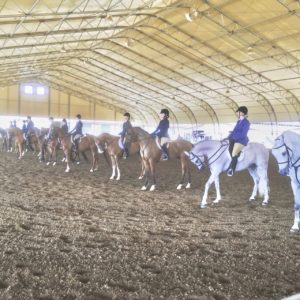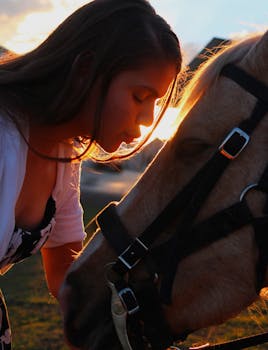
Competing in horseback events is one of the most thrilling athletic events an individual can accomplish. Not only does the rider have to be knowledgeable and apply the principles of riding, but they have to convince an animal that weighs at least several hundred pounds to cooperate in a new and exciting setting. Horse competitions can be strenuous and stressful, but it doesn’t have to be that way. By following some basic horse show etiquette principles, horse events can run smoothly for all. Coaches, parents, riders, and spectators should all uphold a certain code of conduct at horse shows. This not only improves the overall outlook of the equestrian sport, but it provides a safe and positive environment for all to enjoy. Horse show etiquette rules offer a good foundation to improve and establish not only a good horse show, but the equestrian sport overall.
Try your free Horse Show Checklist!!
Competitors
Riders have the most exciting and challenging obstacles at horse competitions. They must recall the lessons and hours of practice put in for their event and also must challenge their horse to listen and remain calm– something many horses have trouble with due to the different scenery than they are accustomed to, riding in a horse trailer, and seeing things they do not normally see at home. For the benefit of everyone, there are certain etiquette rules that should be considered in order to help keep it a safe and enjoyable environment.
Slower movement on the inside, faster on the outside– Like the fast lane on a highway, the faster-paced horses should utilize the outer track of the warm-up ring, with the slower moving horses closer to the inside or to the middle. This allows traffic to flow better and can avoid run-ins or accidents. Don’t be afraid to say “inside” or “outside” when passing-especially if another horse (or yours) is acting up.
If space is tight, reconsider lunging – Breed shows or large shows can have hundreds of horses attending. Warm-up and practice rings can get extremely crowded. Many facilities have designated lunging areas and/or times in order to accommodate the crowded rings, so be sure to ask when and where. If there is no designation, try not to take up a large area of an already tight warm-up space with lunging. Adjusting your hours to early mornings or late evenings to lunge will find a more spacious ring to utilize.
Related Content:
Should Riders Earn Their Stirrups?
Equestrian Organization – Organizational Ideas for Horses and Their People
Side Hustle – Braid Your Way to Extra Money
When riding in practice or showing, you are often allowed to cut across the ring to a less crowded area or ride a large circle to avoid a pack of other competitors. Check your rule book to make sure it is allowed in your class and ride with caution.
Occasional bumps and incidents can occur at horse shows. You may get cut off while riding or you might accidentally cut someone off. If you’re unsure, offer a quick apology. You may be apologizing for nothing, but it’s better to offer an apology than to come across as rude or disrespectful. To practice good horse show etiquette, take the high road when it comes to horse show matters and the experience will be much more pleasant.
Know your tail ribbon colors! A red string or ribbon on a horse’s tail designates them as a kicker! This is very important information to know. Riders should know what a red ribbon tied into a horse’s tail means so they can keep a safe distance to avoid any accidents or injuries.
Horse competitions take a collective effort to participate in. Riders, coaches, trainers, parents and a support team are there to rally behind both horse and rider during the show. Thank your parents and trainer and anyone who is there for you. Their presence is the real present.
Love your horse even if you don’t win. Shows can be exciting and stressful not only for humans but for horses too. New scenery, scary buildings, and noisy crowds often scare horses that are not used to show grounds. Love your horse even if you don’t place or win. Horses can be sensitive creatures and reassuring them that you still love them can be good for both horse and rider.
Instructors/Trainers –
Coaching riders and students at horse shows can be one of the most stressful situations for a trainer. The horse may be skittish and not listening, the rider may be skittish and not listening, the class schedule may test the sanity of any normal person, and then there’s the gear, the setup, the travel, etc. Shows are busy – there’s no doubt about that, but to let you stand out from the rest, consider these instructor/trainer horse show etiquette tips.
Loud, yelling coaching is the number one thing to avoid. Trainers who stand on the rail or in the center of an already crowded ring yelling at the top of their lungs is unsettling. Try to avoid being the trainer that everyone rolls their eyes at. Keep calm and be professional. Your riders and horses can sense a relaxed, confident, and calm persona.
Shows and competitions are no place to correct major training issues. Practice loading into the horse trailer before the show, and have specific steps established for show arrival and pre-class activities and schedules. Planning ahead can prevent safety issues and horse and/or rider blow ups. Horses can be scared or misbehave and there is nothing wrong with correcting the behavior but keep major training sessions limited to home as this can upset other horses, riders, and show spectators.
Spectators-
Spectators generally fall into two categories- those that know horses and those that don’t have a clue. I have had several close calls on my horse due to spectators. One, in particular, finished their delicious Subway sandwich and crinkled up all the wrappers and bags just as my horse walked past in the show arena. We ended up bolting down the arena and I spent the rest of the class trying to calm my horse and convince him that scary things sitting in the stands would not eat him.
If you are attending a horse competition, keep in mind that loud sound, quick movements and scary objects (like strollers and umbrellas – there’s another story there as well) can send a horse into flight mode.
Loud cheering, running, standing suddenly, making noise with chairs, gathering trash, screaming and/or running children (and pets!) can also frighten these large, four-legged animals. The main concern with any horse and rider and at any show is to be safe. Many spectators don’t realize that movements and behaviors they are used to can be startling to a horse.
It is quite acceptable to clap and cheer once the class has lined up for its placings. If any horses seem to be frightened and scurry out of the lineup, please resume a quieter disposition. Safety of the riders is the first and foremost important aspect at any equestrian event.
Parents –
To the parents that got up at 3 am, spent hundreds of dollars on show fees and competition attire and horse lessons-this is for you. You may be tired and cranky, but know your child is doing something they love. Competitors can get snippy due to stress and tiredness, but do not take it personally.
Parents, let the trainers do their job. Offer help if you can or want to but let them do what they are paid to do. Ask if anyone needs anything if you really want to offer assistance, but then step back and enjoy the show 😊
Keep in mind that yes, you want your child to win, but don’t talk bad about the other riders or trainers. This is a key component to good horse show etiquette. This can reflect poorly not only on you but your child and trainer as well. Friendly competition can make everyone better at what they do, but make sure it stays friendly.
Friendly competition can make you a better equestrian, but make sure it stays friendly. Share on XHorse Show Etiquette Overall –
Shows are fun and exciting! Sure, there is stress and chaos – but that is part of what makes it fun. The best shows are planned and practiced well in advance. Trailer your horse to different arenas so they can get used to traveling and new places. Practice loading and unloading a least a few times a month to avoid trailer incidents. Make a schedule and let everyone know what the plans are for before, during, and after the rides. Pack in advance and use a checklist so you don’t forget anything. For a free horse show checklist click Horse Show Checklist!
There are many ways to show good horse show etiquette. A few golden rules of horse show etiquette that everyone can benefit from are:
Speak Politely
Demonstrate Good Sportsmanship – all parties
Be a positive role model – you never know who is watching.